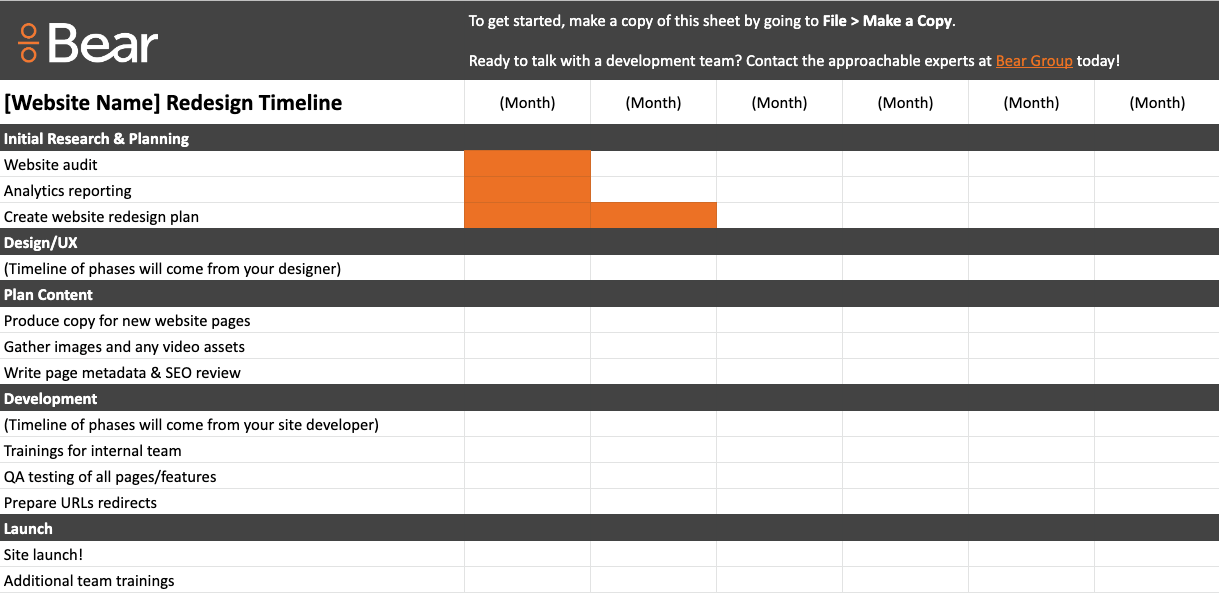Start your website redesign planning
Are you tasked with leading your company’s upcoming website redesign but not sure what to expect or how to get organized?
Web redesign projects are large undertakings that often fall on the shoulders of in-house marketing professionals who already wear many hats. Before you kick things off with an external website development agency, there are several things you can do to get your internal team on the same page.
Dedicating time early in the website redesign process to clearly define the goals for your new website and plan your redesign approach will help the project go more smoothly, save time, and make launch day that much more enjoyable.
Before we dive into project planning, let’s look at the four high-level phases included in most website redesign projects.
But first, what are the phases of a website redesign?
- Planning: You’ll craft your project plan, do some initial research, and begin pulling together some of the content requirements for your new website.
- Design/UX: Working with a design team, they’ll get to know your brand and work to create the designs and user experience you’d like to see for your new website.
- Development: With your new designs and style guide in hand, the development team will begin setting up your new website environment, mapping any technologies that need to connect, and writing the code necessary to bring your designs to life.
- Pre/Post Launch: As you approach the day your new site will go live, you’ll get all content in place, do thorough QA, and plan URL redirects before launching the site (hooray!), followed by additional testing and monitoring to make sure everything is right.
Each phase of a website redesign builds upon the effort you put into the preceding phase. Get your project off to the right start by investing time in the planning phase.

What to put in your website redesign project brief
One of the first things worth doing is setting up a clear project brief to create internal team consensus around the project’s high-level goals. This can also be useful as you reach out to potential design and development partners to help highlight your priorities and get them up to speed quickly.
At a minimum, your website redesign project brief should include:
- Goals for the redesign
- Your defined website audiences
- Technology stack
- Team roles and responsibilities
- Your timeline
- Estimated budget range
Download The Organized Marketer's Guide to Leading a Website Redesign for the free Website Redesign Planning Workbook.
1. Establish website redesign goals
This may seem like an obvious one, but it’s important to have your team clear on the goals for the new website and the order of priority of those goals. When defining the goals for your new website, ask:
- What does your new website need to do?
- What reasons and institutional goals does your company have for redesigning the website? (New brand, want to improve the user experience, need it to be easier to manage, etc.)
- How does your website contribute to your overall business goals? What business goals and key performance indicators (KPIs) must your website achieve? (Sales, inquiries, etc.)
Include in your plan:
- List your 3 primary redesign goals (improved UX, easier to manage, new brand, etc.).
- List your 3 primary business goals (sales opportunities, other KPIs).
2. Define your website audience(s)
This goes hand-in-hand with defining your goals, but it’s important to have clearly defined audiences going into your website redesign. Your website's key audiences won’t necessarily be the same as your marketing audiences. Identify likely website visitors and make sure you have your target audiences clearly defined going into your website redesign. What are their needs and expectations? What do they want to experience?
Include in your plan:
- List your website’s primary and secondary audiences. Who are they and what are their needs?
3. Note your technology stack
What marketing/business tools will you need to connect with your new website? Are there any custom integrations you’ll need like connecting your website with your ERP, POS, or another system? Be sure to note anything in your technology stack to help your website development team with scoping. The more you’re able to provide upfront, the better!
Include in your plan:
- List any marketing or business tools you need to connect with your website along with any platform preferences or requirements.
4. Establish team roles and responsibilities
Create a clear overview of the members of the team involved in the website redesign project and what each person or partner’s role(s) will consist of. This will often include the immediate marketing team working on the new website, as well as larger stakeholder groups that may include HR, Finance, Customer support, as well as your CEO or board members. Include reviews for this wider stakeholder group so they feel included in your schedule at key milestones.
Include in your plan:
- List the members of your team and their roles during the redesign (project lead, content contributor, decision maker, etc.)
5. Create a project timeline
When do you need your new website to go live? Depending on the scale of your redesign project, it’s safe to give yourself at least 6 months for content preparation, design, and development of your new site. Working backward from your ideal launch date, outline the steps involved and space things out so you’re not having to cram everything in at the very end while building out your new website.

Don’t put yourself in the position of rushing the writing process and having to find and edit images at the last second when your development team is ready for them.
Include in your plan:
- When do you need to launch your new website? What marketing or business initiatives are driving this timeline? How long will it take you to prepare content?
6. Determine your project budget
How much do you need to budget for your new website? The cost of a website redesign varies dramatically depending on how custom you need it to be. Each of these factors can drive your website redesign budget up or down:
- What other systems do you need your website to integrate with? Do they come with their own API that you can use as a connector or do you need something custom-built?
- How custom do you want to make your website’s design theme and UX? How much do you want to differentiate your brand online?
- Is your priority to invest more upfront for high-quality development and get a website that will serve your business in the longer term, or invest less on shorter-term solutions?
Include in your plan:
- What is your project budget? Do you have a range in mind? Is there a firm cap you need to communicate? Do you have any budget set aside for post-launch development support of your new website?
Need help to estimate the development costs for your new website? We can provide you with a free estimate. Reach out today to schedule a call with our team.
Additional budget resources
We’ve written several blog posts about the price of new websites broken out by the three primary platforms we work within:
- How much does a Drupal website redesign cost?
- Shopify Plus vs Shopify Advanced: How much will they cost?
- How much is an Adobe Commerce (Magento) website going to cost?
If you pull together these six items as the basis for your initial website redesign project brief, you’ll be off to a great start.
What next? Stay tuned for our next tutorial on initial research you can start early in the redesign process — or access it now by downloading a free copy of The Organized Marketer’s Guide to Leading a Website Redesign.
Cathy Morris is the Director of Marketing and Communications at Bear Group and is eager to share what she’s learned leading five website redesign projects as an in-house marketer for K-12, nonprofit, and B2B organizations over the past decade. Have a question? Reach out to Cathy.
